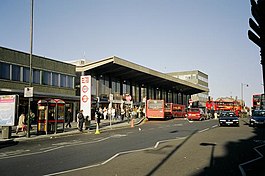Barking station
Appearance
| Barking | |
|---|---|
 The station forecourt in 2004 | |
| Location | Barking |
| Local authority | London Borough of Barking and Dagenham |
| Managed by | c2c |
| Owner | Network Rail |
| Station code | BKG |
| DfT category | B |
| Number of platforms | 9 (facing 8 tracks) |
| Accessible | Yes[1][2] |
| Fare zone | 4 |
| London Underground annual entry and exit | |
| 2017 | |
| 2018 | |
| 2019 | |
| 2020 | |
| 2021 | |
| National Rail annual entry and exit | |
| 2013–14 | |
| – interchange | |
| 2014–15 | |
| – interchange | |
| 2015–16 | |
| – interchange | |
| 2016–17 | |
| – interchange | |
| Railway companies | |
| Original company | London, Tilbury and Southend Railway |
| Pre-grouping | Midland Railway |
| Post-grouping | London, Midland and Scottish Railway |
| Key dates | |
| 1854 | Opened by LT&SR |
| 1902 | District line started |
| 1905 | District withdrawn |
| 1908 | District line restarted |
| Listed status | |
| Listed feature | Booking hall |
| Listing grade | II |
| Entry number | 1242678[9] |
| Added to list | 24 November 1995 |
| Other information | |
| External links | |
| WGS84 | 51°32′21″N 0°04′54″E / 51.5393°N 0.0817°E |
Barking station is a railway station served by National Rail, London Underground and London Overground services. It is in Barking in the London Borough of Barking and Dagenham in East London. The station is in Zone 4 and is managed by c2c.
Gallery
[change | change source]Wikimedia Commons has media related to Barking station.
-
Station Building
-
Eastbound District line platforms 1a (right) and 2 (left) looking west
-
Main line platforms 4 and 5 looking east
-
Station signage
References
[change | change source]- ↑ "Step free Tube Guide" (PDF). Transport for London. March 2019. Archived (PDF) from the original on 1 June 2019.
- ↑ "London and South East" (PDF). National Rail. September 2006. Archived from the original (PDF) on 6 March 2009.
- ↑ "Multi-year station entry-and-exit figures (2007–2017)". London Underground station passenger usage data. Transport for London. January 2018. Archived from the original (XLSX) on 31 July 2018. Retrieved 22 July 2018.
- ↑ "Station Usage Data" (CSV). Usage Statistics for London Stations, 2018. Transport for London. 21 August 2019. Archived from the original on 22 May 2020. Retrieved 27 April 2020.
- ↑ "Station Usage Data" (XLSX). Usage Statistics for London Stations, 2019. Transport for London. 23 September 2020. Archived from the original on 9 November 2020. Retrieved 9 November 2020.
- ↑ "Station Usage Data" (XLSX). Usage Statistics for London Stations, 2020. Transport for London. 16 April 2021. Retrieved 1 January 2022.
- ↑ "Station Usage Data" (XLSX). Usage Statistics for London Stations, 2021. Transport for London. 12 July 2022. Retrieved 7 September 2022.
- ↑ 8.0 8.1 8.2 8.3 8.4 8.5 8.6 8.7 "Station usage estimates". Rail statistics. Office of Rail Regulation. Please note: Some methodology may vary year on year.
- ↑ Historic England. "Details from listed building database (1242678)". National Heritage List for England (NHLE). Retrieved 12 November 2012.






